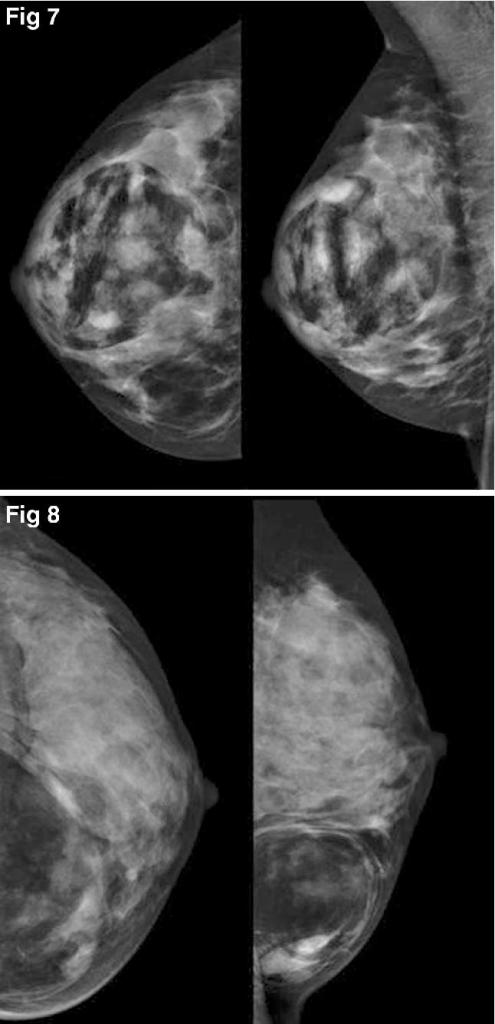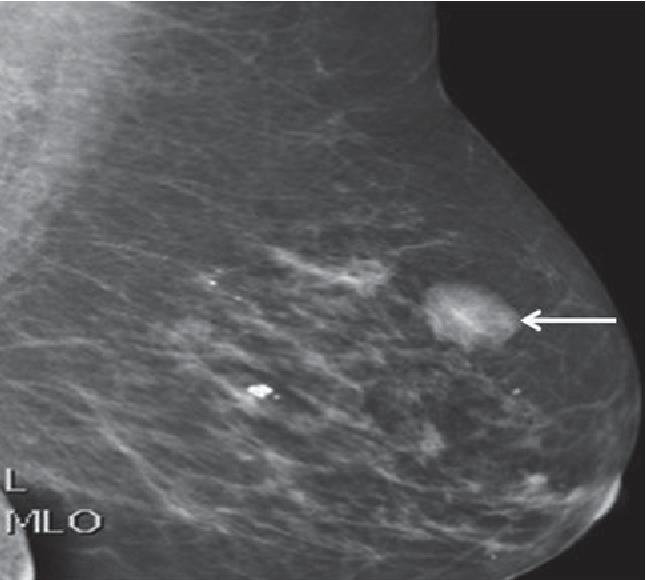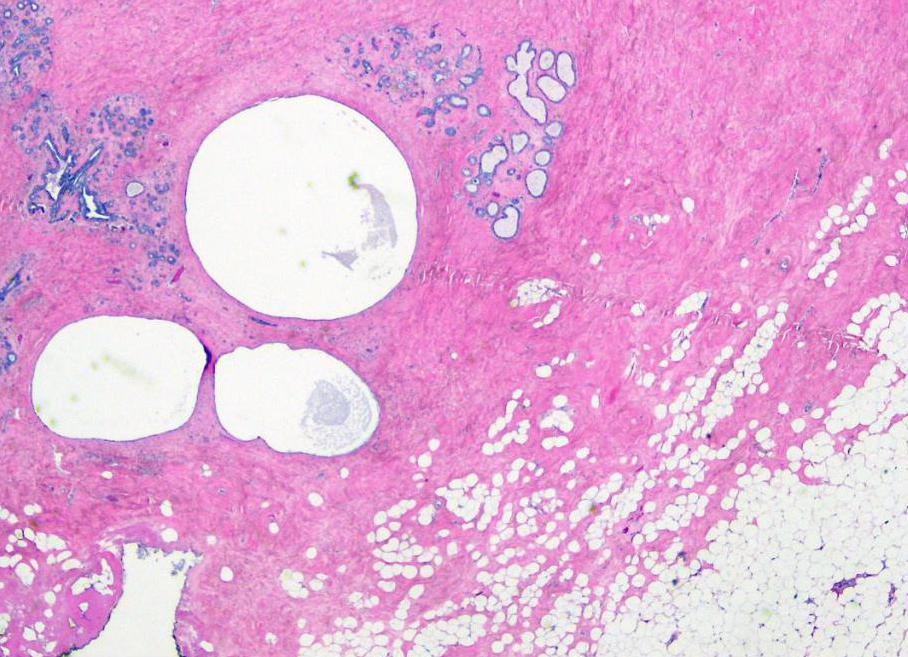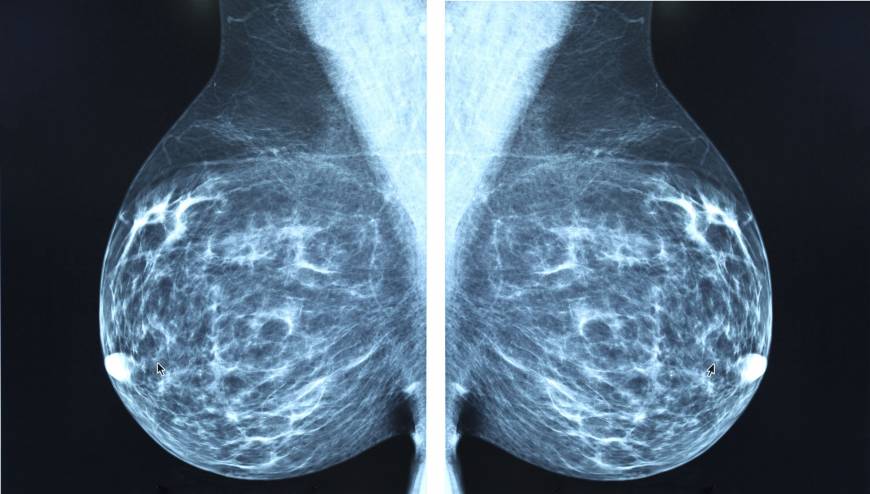Benign formations in the body are always dangerous and harmful to human health. In most cases, they grow slowly, spreading to nearby tissues. Breast hamartoma is a benign neoplasm that appears as an abnormality. In most cases, violations of the laying and sale of tissues during embryonic development lead to such a problem.
Detailed definition of the term "hamartoma"
Hamartoma is a seal in the mammary gland. It is represented by a knotted area, which is fat, glandular and connective tissue. In most cases, the seal remains small, so for a long time it is not detected. This type of tumor is not particularly dangerous. Removal is carried out at a large size or when the seal brings discomfort to a person.

In the presence of a benign neoplasm in the mammary gland, it is important to conduct a full-fledged diagnosis: a complex of studies and surgical intervention, if it is really required.
Features of the neoplasm
When diagnosing a node, only one of the two mammary glands considers on-alertness - the doctor must necessarily conduct all examinations to exclude the growth of cancer cells, and quickly operate the patient to improve her condition and maintain health. Having revealed a benign process, it is important to make an accurate diagnosis, determining the state of the histological structure of tissues. Hamartoma is a tumor that has the following features:
- appears at the embryonic stage (refers to congenital malformations);
- for a long time does not give itself away with any symptoms (in most cases it is diagnosed in people over thirty years old);
- slowly but surely increasing in size (tumor growth);
- includes normal breast tissue;
- transition to a malignant form occurs in rare cases.

A benign breast formation as it grows leads to a lot of difficulties in a woman. During treatment, the doctor suggests an operation using organ-preserving surgery. After eliminating the formation of any complications, as a rule, does not arise.
For some time after the operation, you need to regularly go to the doctor for an examination, but after several years after the removal of education, you can forever forget about the disease. In order to prevent, experts recommend once a year to go to an institution where you can do a mammogram.
The main symptoms
In most cases, breast hamartoma is diagnosed in patients aged 30 to 40 years with a routine examination or with independent monitoring of the condition of the breast. Common symptoms include:
- in the mammary gland, you can determine the characteristic elastic node (dense or soft);
- the boundaries of the node are even (no tuberosity);
- the woman’s chest rarely hurts;
- the presence of mobility;
- The total size of the assembly exceeds three centimeters in diameter.

If timely treatment is not provided, the size of the elastic node in the mammary gland can reach 20 cm. When the neoplasm grows, the patient may experience pain that occurs as a result of compression of neighboring tissues (nerves or blood vessels). The area under the skin can be identified by a pronounced cosmetic defect.
Regardless of the mammary gland in which the tumor is located, as well as the presence or absence of signs of the disease, it is important to conduct a comprehensive examination of the breast with the obligatory identification of the histological structure of the neoplasm.
Common methods of examination
In addition to conducting palpation at the beginning of the study, it is important to conduct a basic diagnosis, which the attending physician establishes. Its methods include:
- ultrasound examination of the breast;
- mammography;
- suction biopsy;
- MRI (depending on the specific situation).
When conducting an ultrasound, it is quite difficult to determine a neoplasm in the mammary gland, since it includes the usual tissues for the breast (glandular, fibrous, and also fat). The easiest and most convenient way to diagnose a hamartom is through mammography (in this case, a node with characteristic contours will be clearly visible).

Through an aspiration biopsy , cells are taken from the tumor formation, but in most cases, after a laboratory examination, the doctor receives an acceptable cytological picture, since a hamartoma includes normal breast cells.
At the center of mammology, specialists will be able to determine a clear outline of the neoplasm in the chest. When carrying out a fine-needle aspiration punctuation biopsy, it may seem that the specialist took the biological material not from the formed site, but from a healthy area, since the tissue of the mammary gland is found in the contents. Surgical intervention is mainly carried out with a differential study or at the request of a woman, when the mammary gamartoma reaches a really large size.
ICD-10 code
The oncologist must correctly encrypt the disease. The ICD-10 code for hamartoma in the mammary glands is D24. This is a benign tumor in the chest, which includes soft tissues and connective structures. The doctor must correctly identify the symptoms and treatment of hamartoma in the mammary gland. Comprehensive diagnostics and the correct diagnosis are the basis for the full treatment of the disease and the patient’s soon recovery.
When is it important to start treatment
When determining any neoplasm in the chest, it is very important not to wait and immediately conduct a comprehensive study with subsequent treatment. In this case, traditional medicine or alternative therapy can only worsen the problem due to the loss of time. Hamartoma is a benign tumor with a limited structure. But in the absence of proper treatment and diagnosis, the following difficulties may arise:
- The rapid increase in the size of education.
- The woman’s chest is very sore.
- Circulatory disturbance in the vessels of the mammary glands.
- The process of changing the shape of the tumor to malignant (the possibility of the appearance of hamartoblastoma is small, but you can completely protect yourself from the degeneration of hamartoma only through surgical intervention).

The best treatment for hamartoma is considered surgical treatment, during which the specialist applies organ-preserving techniques.
Operation
It makes no sense to treat neoplasms in the chest with drugs. The most effective treatment in this case will be surgery. Tumor removal can occur using two methods:
- husking of a neoplasm;
- sectoral resection.
Given that it is possible to accurately determine the disease only after a histological examination of the node, then after surgery it is important to wait for the results from the laboratory department. If a node in the chest was found, then it is not worth worrying especially, since the timely elimination of a benign formation will not affect the patient's condition.
It is important to remember that any node in the mammary glands is dangerous. You should not be afraid of the operation, as the treating specialist will do everything to reduce the strength of postoperative injury and carry out organ-preserving surgery.
Pregnancy Disease
The determination of hamartoma in the mammary glands during pregnancy is complicated by the fact that many diagnostic methods are forbidden to use during the bearing of a child, for example, x-rays. In most cases, a specialist can only assume the presence of nodular formation, and make an accurate diagnosis only after the birth of a child. Specialists in the center of mammology use the following methods for determining the disease:
- the study of complaints of a pregnant woman;
- blood analysis;
- Ultrasound
- MRI (excluding the first trimester, when the embryo is just starting to develop).

To distinguish hamartoma in the chest from malignancy, cysts and pneumofibrosis, puncture is used. Invasive diagnostics help to accurately determine the status of the disease and choose the best treatment method in a particular situation.
Possible complications
Hamartoma in extremely rare cases takes on a malignant form, but there is still a chance of such an outcome. The main threat of the disease is considered to be the absence of severe symptoms, for this reason in most cases the formation in the chest is diagnosed only when it reaches an especially large size.
Large hamartoma in the chest can adversely affect the normal functioning of the mother’s organs and systems (for example, organs can be damaged due to regular pressure on them). All this affects both the course of pregnancy and the health of the child. If a pregnant woman has a knot, there is a high chance that the baby will have a disturbance in the laying of tissues at the stage of embryonic development, which will increase the chance of the appearance of hamartoma in the child.
Treatment for a lactating woman
If you suspect the presence of hamartoma during lactation, it is important for a woman to go to a clinic where you can do a mammogram. After all the studies, the doctor gets the appropriate results and prescribes an effective course of treatment for the disease. Sealing in the mammary gland during breastfeeding is treated exclusively under the supervision of a doctor. If a woman who is feeding a baby has dangerous symptoms, then she should immediately consult a doctor.

Treatment of breast compaction during breastfeeding will be determined depending on the site of the node, its size and symptoms. The specialist can choose one of three treatment methods:
- taking medications (only eliminates the symptoms);
- operation;
- irradiation.
Any form of formation in the chest requires removal. To eliminate the tumor, you need to use minimally invasive methods. You can get rid of the symptoms of the disease with the help of special medicines: they are taken both before the operation and after it.